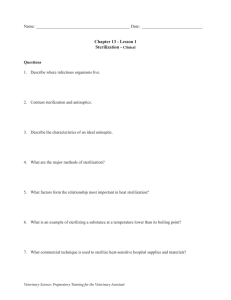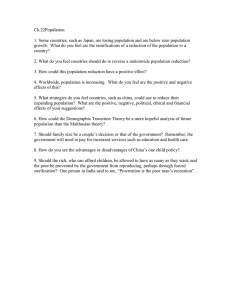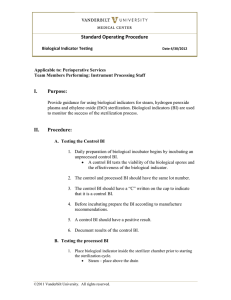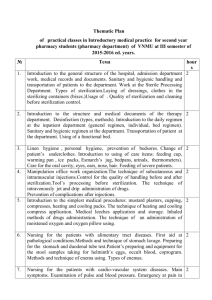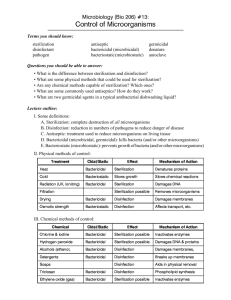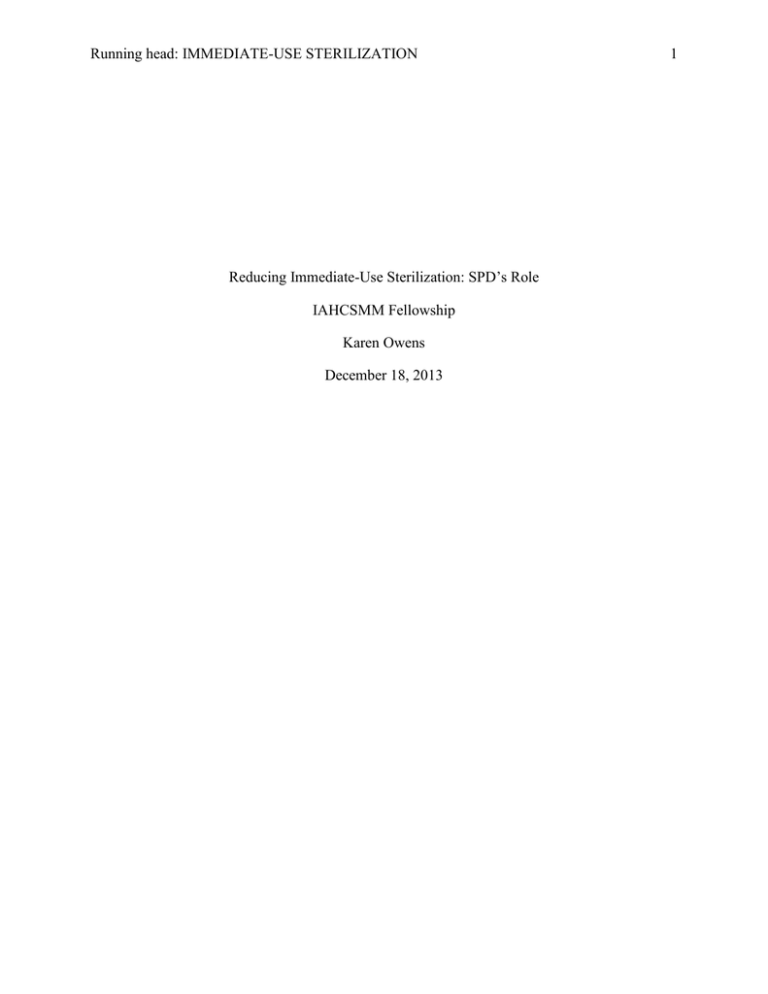
Running head: IMMEDIATE-USE STERILIZATION
Reducing Immediate-Use Sterilization: SPD’s Role
IAHCSMM Fellowship
Karen Owens
December 18, 2013
1
IMMEDIATE-USE STERILIZATION
2
Immediate-Use Sterilization
Introduction
A zero percent immediate use sterilization rate is endorsed by the Joint Commission on
Accreditation of Healthcare Organizations and the Association of Perioperative Registered
Nurses (AORN, 2012). While the immediate use sterilization rates at Jewish Hospital have
improved over the last two years there is still room for improvement. There are three main
issues related to immediate use sterilization. The first issue involves proper cleaning and
decontamination according to manufacturer’s recommendations. The second is using the
appropriate parameters according to the device manufacturer, sterilizer manufacturer, and the
manufacturer of the container or packaging materials used. Third is transport to the sterile field.
These variables leave considerable room for error which could result in patient harm. The best
way to avoid this is to eliminate immediate use sterilization except in life or limb threatening
situations.
Background Discussion
“Flash sterilization” is an out dated term that has traditionally been used to describe steam
sterilization cycles where unwrapped surgical instrumentation is processed in a shorter
sterilization cycle with little or no dry time then taken directly to the operating room to be used
(TJC, 2009). This type of sterilization does not allow for instruments to be stored due to
moisture from minimal drying. However, traditional “terminal sterilization” cycles utilize longer
steam exposure and significantly longer dry times. This allows instruments to be containerized
or wrapped in a way that will maintain the instruments’ sterility so that instruments may be
stored until they are needed for use (Young, 2013). The term “immediate use” was meant to
more accurately describe the minimal time between an item being sterilized and being
transferred to the sterile field for immediate use (TJC, 2009).
IMMEDIATE-USE STERILIZATION
3
“Flash sterilization” was originally created for use in emergency situations or when a one-ofa-kind instrument was contaminated or dropped off the sterile field. There needed to be a way to
get these instruments back to the sterile field quickly. Traditional terminal sterilization can take
up to 90 minutes, which is not acceptable during a procedure. Unfortunately, this method is now
used to often as a matter of convenience and also to compensate for lack of sufficient instrument
inventory. In these situations important steps are skipped such as proper decontamination before
sterilization. This has prompted many professional groups and accreditation agencies to
recommend that immediate use sterilization should not be a routine practice (TJC, 2009).
Importance of proposed project
Today, preventing surgical site infections and hospital readmissions is a top priority for
healthcare facilities. All patients that are admitted to the hospital are at an increased risk of
infection simply by being there. This risk increases further when they undergo an invasive
procedure or surgery. Potentially adding to that risk could be an abbreviated sterilization cycle
for surgical instrumentation used in their procedure. Operating room and sterile processing
professionals must become aware of the issues surrounding this form of sterilization. It is vital
that immediate use steam sterilization be utilized in accordance with professional guidelines and
facility policies and procedures. It is the responsibility of the manufacturer to test and validate
their product or device for sterilization and provide those instructions in writing to the facility.
The responsibility then lies on the end user to follow those written manufacturer’s instructions
for use.
Purpose of proposed project
The purpose of the proposed project is ultimately to significantly reduce or even eliminate
immediate use sterilization. The issue is not that immediate use sterilization is not safe and
effective for sterilization of critical medical devices; it is that it is not done correctly and for the
IMMEDIATE-USE STERILIZATION
4
appropriate reasons. It is a complex process that includes multiple steps and can vary slightly for
each different medical device. It is necessary to follow the manufacturer’s written instructions
for each device to ensure the sterility of the instruments to the point of use. There can be no
margin of error. If the instruments are not processed properly it could result in the use of
contaminated instruments in surgery, which in turn could result in a surgical site infection. Due
to the serious nature of the consequences it is imperative that healthcare facilities reduce or
eliminate their reliance on this process. Reducing or eliminating immediate use sterilization is a
major commitment that involves increasing surgical instrument inventory, creating a scheduling
conflict mechanism, and educating all those involved with immediate use sterilization (Young,
2013).
Project Goals
Goal One
Reduce the immediate use sterilization rate in surgery 25% by December 1, 2013 and 50%
in 6 months or less. (Current IUS rate is 36%, goal by December 1 is 27% or less)
Objectives
1. Meet with June Waiz, RN, BSN, MBA, Director of Surgical Services, to summarize
proposed project and outline time commitments.
2. Create metrics to validate quality expectations are met upon completion of the project.
3. Review case volumes requiring the same instrument trays.
4. Work with scheduling coordinator to identify surgeon’s block times that require the same
instrument trays.
5. Implement progressive discipline process for vendor representatives who consistently do
not deliver trays 24 to 48 hours in advance. First offense verbal warning, second written
warning, and third no access to the facility for six months.
IMMEDIATE-USE STERILIZATION
5
6. Identify surgeons using their own personal instruments, day of surgery
Goal Two
In-service 100% of the operating room staff in their role to reduce IUS by September 11,
2013.
Objectives
1. Create power point presentation to use for in-servicing operating room staff.
2. Schedule auditorium for in-services.
3. Meet with operating room managers to schedule best times to schedule in-servicing.
4. Print copies of Joint Commission on Accreditation of Healthcare Organizations
(JCAHO) and the Association of Perioperative Registered Nurses (AORN) standards for
immediate use sterilization to hand out to the operating room staff.
Goal Three
Identify top ten trays that are IUS and get quotes to purchase additional trays by September
2, 2013.
Objectives
1. Review sterilization log books for the past year to determine trends, reasons for
immediate use sterilization, and top ten trays that are immediate use sterilized.
2. Print count sheets for top ten trays and provide information to instrument vendors to get
pricing for trays.
Budget Implications
The cost of additional instrumentation needed to eliminate the need to turnover trays will be
the largest expense of the proposed project. Other costs will be staff salary hours to participate
in servicing, meetings, and providing information and feedback. Printing of documents and
IMMEDIATE-USE STERILIZATION
6
copies for in servicing can be done with the surgical services printers and copiers with minimal
cost of paper. With the skyrocketing costs of surgical site infections and penalties for
readmissions eliminating one surgical site infection could potentially cover the costs of the entire
project. (Appendix B).
Conclusion
Immediate use sterilization can be a safe and effective process if used correctly. However, it
should not be used as a matter of convenience or to compensate for the lack of surgical
instrument inventory. In order to reduce the reliance on this process, healthcare facilities need to
be certain that they are managing their assets appropriately. Understanding the reasons behind
immediate use sterilization in a particular facility can help create sustainable solutions.
Ultimately, having well educated staff and open communication between the operating room and
sterile processing professionals can serve to deliver the highest quality product for each and
every patient.
IMMEDIATE-USE STERILIZATION
7
Chapter 2: Resources
Timeline
Developing a timeline for this project was necessary in order to meet the goals and keep
the project on track. The first step was to meet with the OR Director to determine appropriate
goals and a reasonable timeline. To begin the project it was necessary to meet with the OR nurse
that is responsible for compiling the immediate-use sterilization data from the daily logs. By
reviewing the last six months of data this nurse was able to determine the top ten trays or sets
that are immediate-use sterilized most often. From this list, quotes were requested from vendors
to purchase instruments needed to assemble additional trays. To ensure success of the project the
surgery staff needed to be in-serviced on the reasons to avoid immediate-use sterilization,
alternatives to immediate-use sterilization, as well as the proper process in case of a life or limb
threatening situation. Educating the vendors and surgeons on the policy for delivery of trays
twenty-four hours in advance was also necessary. Finally, the data from November will be
evaluated to determine if the immediate-use sterilization rate decreased. (Appendix A).
The timeline for the project is tight with only twelve weeks to meet the goals. Start time
and end time run from September 1, 2013 until December 1, 2013, as demonstrated by the
timeline. The budget has been determined and is costly due to the high price of surgical
instrumentation as well as surgery staff time to attend in-services. Basic supplies needed for the
project were paper and printing for handout materials.
In-services were held in the hospital auditorium. Reserving the space for in-services did
not pose any problems due to the unusual time it was needed. Most in-services occurred very
early in the morning or late in the evening. Reserving the space required coordination with the
administrative assistant and there was no cost for using the space.
IMMEDIATE-USE STERILIZATION
8
The entire surgery staff including the surgeons will be impacted by this project. In order
for the project to be successful the surgery staff, surgeons, and vendors must be aware of the
goals and understand the reasons immediate-use sterilization should be avoided and alternatives
to immediate-use sterilization. Without the commitment of the entire staff the outcomes will not
be sustainable. Currently there is no consistent research that shows ac correlation between
immediate-use sterilization and surgical site infections. This type of data could be helpful for
practitioners to better understand the risks of immediate-use sterilization. Changing habits also
involved changing mindsets; the attitude of “that is how we have always done it” is simply not
acceptable.
This project will continue on until mid next year in order to hardwire the new process.
Monitoring the immediate-use sterilization rates for the rest of the year will allow time to realize
the full impact of additional instrumentation as well as staff, physician, and vendor education.
Results for the month of September will be shared with the operating room Director and Vice
President on October 8, 2013. A full report will be shared with the Operating Room Executive
Committee at their monthly meeting on October 24, 2013. Message boards will be uploaded
with the September results for the surgery staff on October 18, 2013.
IMMEDIATE-USE STERILIZATION
9
Chapter 3: Literature Review
Immediate-use sterilization has become a focus of process improvement across the nation
since The Joint Commission on Accreditation of Healthcare Organizations released its position
statement in 2009. It would be difficult to find a hospital that has not been through at least one
initiative to dramatically reduce or even eliminate immediate-use sterilization all together. There
are many journal articles as well as specific standards and recommendations on immediate-use
sterilization from the Association of periOperative Registered Nurses (AORN) and The Joint
Commission (TJC).
The recommendations that are set forth by AORN are intended to be achievable and take
into consideration all practice settings. Surgeries and invasive procedures are performed in many
areas other than the traditional operating room setting. The guidelines are adaptable to settings
such as cardiac catheterization labs, ambulatory surgery centers, radiology departments,
endoscopy suites, labor and delivery, and physician’s offices. The facility policies and
procedures should reflect these recommendations which are considered to be optimal practice
(AORN, 2012).
TJC (2009), position statement on immediate-use sterilization gives specific focus and
recommendations on all of the critical points in the process of immediate-use sterilization. These
include but are not limited to the qualifications and education of the staff performing these
functions, management, and monitoring of immediate-use sterilization. The same critical steps
that are used in terminal sterilization must be followed; short-cuts are not acceptable. It is also
made clear that immediate-use sterilization must not be used to compensate for inadequate
instrument inventory.
Keeping current with evidence based practice and updated recommendations is
imperative for all personnel that are involved with the sterilization process. The end goal is to
IMMEDIATE-USE STERILIZATION
10
keep patients safe and prevent surgical site infections. The most recent update in June 2012 to
the AORN “Recommended practices for sterilization” was the first document to undergo the
evidence-rating process. “AORN implemented this process to help nurses understand the quality
of the research behind each recommendation” (Graybill-D’Ercole, 2013).
Implementing recommended practices to the full extent is not always as easy as it sounds.
Overcoming obstacles that may impede process changes can be facilitated by a shared
governance quality improvement team. Involving, empowering, and educating staff can
facilitate the reduction of immediate-use sterilization. Learning to utilize resources more
effectively and streamlining processes to better meet the needs of the operating room are
important first steps. When the surgery staff is committed to ensuring that all patients receive
the same standard of quality care, the results can be amazing. (Shelby, Kras, Bryant, Myers, &
Bolyard, 2012).
Sterile processing and operating room professionals would prefer to have a clear target
for immediate-use sterilization. However, there is no “acceptable” level; the key is to only use it
after every other possible solution has been exhausted. The other critical piece is following all of
the appropriate steps including manufacturer’s instructions. Another point of confusion is when
manufacturer’s recommend sterilization times that are outside the norm. To address this issue
the Food and Drug Administration as well as the Association for Advancement of Medical
Instrumentation are attempting to create standard recommendations for the manufacturer’s to
validate within (Pyrek, 2011).
In order to have a clear understanding of why it is important to decrease or even eliminate
immediate-use sterilization we must first be aware of the consequences. “Surgical site infections
affect two percent to five percent of all patients undergoing surgery. Surgical site infections can
increase hospital length of stay for up to seven to ten days” (CDC, 2008). Performing
IMMEDIATE-USE STERILIZATION
11
immediate-use sterilization correctly and using only when deemed appropriate can help to avoid
the high cost of surgical site infections and the undue harm to patients. Effective communication
and education are essential elements to the successful reduction of immediate-use sterilization
(Stoutzenberger, 2011).
Overuse and misuse of immediate-use sterilization cannot be eliminated without adequate
data. Operating room management must know the reasons why items are being immediate-use
sterilized. Certain instrument trays that are frequently being immediate-use sterilized due to lack
of sufficient inventory need to be requested for capital purchase. Infection control also needs to
be aware of trends and data that are collected. Keeping proper sterilization logs that record daily
sterilizer testing as well as every load that is processed are legal documents. The data that is
needed is already there, it just needs to be evaluated, shared, and acted upon when necessary
(Young, 2013).
Sterilization short-cuts are not acceptable in any environment or any situation. As
healthcare professionals we should ensure that our processes are aligned with best practices.
More attention has been given to immediate-use sterilization practices over the past five years
which has caused everyone to take a closer look. Patient safety and quality will continue to
impact hospital scores and reimbursements in the future (Williamson, 2012).
There is no shortage of information on this topic and it does not appear that any less
attention will be given to this critical process in the near future. As consumers continue to
research and become more involved in their healthcare options hospitals must continue to raise
the bar and focus on excellence and high quality care. Consumers have all the information that
they need right at their fingertips.
IMMEDIATE-USE STERILIZATION
12
Chapter 4: Management Concepts
Managers play an important role in health care organizations as well as many others. It
can be a challenging but also very fulfilling role. The skills and knowledge required to manage
people and departments in health care today are vast. The following best describes the
management concepts chosen for this project.
Managing change is not always an easy task but as a manager it is a necessary task. The
health care environment is evolving and in order to stay aligned with best practices change is
necessary. Managers must remain enthusiastic and knowledgeable about the change in order to
encourage staff participation. The process of evidence-based practice is first identifying the
clinical question. Next, finding the evidence to answer the question, evaluating, then applying
the evidence, and finally evaluating the outcome (Sullivan & Decker, 2009).
When implementing best practices it is not unusual to encounter obstacles. How these
obstacles are overcome is the important piece. Pulling together the team and comparing
experiences from other facilities can be helpful to find common ground. There may be those
who doubt that the recommendation can be implemented to the full extent (Shelby, Kras, Bryant,
Myers, & Bolyard, 2012). There were several operating room staff who had been involved in the
same initiative at another facility. Listening to their ideas and hearing that it is possible was very
helpful. As a manager, the ability to inspire a shared vision, empower and encourage others, and
lead the way can go a long way to remove obstacles.
Quality improvement is something that every health care professional should strive for.
As a manager providing the highest quality of evidence to support necessary change can give
staff a level of comfort that the change is necessary and for the better. For the operating room
staff the AORN standards are understood to be their professional standards for practice. The
‘Recommended practices for sterilization’ is the first AORN document to achieve the distinction
IMMEDIATE-USE STERILIZATION
13
of being accepted to the National Guideline Clearinghouse, and initiative of the Agency for
Healthcare Research and Quality” (Graybill-D’Ercole, 2013).
Communication is critical to success for any project in order to convey a common vision
and expectation (Sullivan & Decker, 2009). For this project there were many different groups of
people working at various times of day that needed specific information for the project to be
successful. This also meant that face-to-face communication was not always possible. In order
to manage the communication effectively some creativity was required. The presentation that
was given was video-taped and placed on the intranet in order for it to be easily accessed at any
time of day. Extra effort was also required to communicate with busy surgeons and vendors
traveling between multiple facilities.
As a manager when we consider our resources, time is a very valuable resource that we
often take for granted and even waste at times. There are many things that waste our time, some
of which we can control and some we cannot. Lack of clear-cut goals and priorities, failure to
delegate, ineffective communication, and lack of personal organization are a few time wasters
(Sullivan & Decker, 2009). This project had a very brief timeline and every step was critical to
success. Time management and effective goal setting helped to keep this project on track.
In appreciation for time spent helping to facilitate this project and for the extra effort of
the surgery staff, thank you notes were sent. Showing appreciation for the contributions that
others make is a very important step that should never be forgotten. Romans 12:3b-4 tells us
“Do not think of yourself more highly than you ought, but rather think of yourself with sober
judgment, in accordance with the faith God has distributed to each of you. For just as each of us
has one body with many members, and these members do not all have the same function.” As a
team and together in Christ we are capable of worthy service.
IMMEDIATE-USE STERILIZATION
14
Chapter 5: Project Summary
The vast majority of reasons why immediate-use sterilization is used are preventable, which
was the main focus of this project. Insufficient inventory of trays, issues with loaner trays from
vendors, care and handling issues, and lack of knowledge were all factors involved.
Unpreventable reasons for immediate-use sterilization are contamination during a case, humidity
issues, and emergency procedures. The main goal of this project was to reduce immediate-use
sterilization 25% by December 1, 2013. The immediate-use sterilization rate for August 2013
was 36%; the final rate for November 2013 is 16%, a reduction of more than 50%.
Constraints encountered include time and availability of staff and surgeons. These obstacles
were expected due to the short timeline and fast pace of the operating room. In order to
overcome these obstacles this nurse had to come in at various times to accommodate night and
weekend staff for in-servicing. Meeting with surgeons at times that are convenient for them was
also helpful in building relationships and accomplishing the goals.
Monitoring progress of the project was fairly easy as the immediate-use sterilization records
are filled out consistently at the point of use and are easy to access. This nurse made a point to
review the records each week and compile information accordingly. It was expected that during
the initial phase of the project there would be a significant decrease in the immediate-use
sterilization rates. With much attention on the project and education being done it is foremost in
the minds of the operating room staff. As the project continues, close and careful monitoring
will be necessary to prevent old habits from reemerging.
During the project this nurse learned about all of the unexpected benefits of a project such as
this. In the spirit of cooperation, collaboration, and respect the relationships that were built
between the operating room and sterile processing staff during this project will continue to grow
and prosper. Ultimately to better serve the patient by functioning as competent peers alongside
IMMEDIATE-USE STERILIZATION
15
their expert operating room teammates. The positive effects of these relationships will continue
to influence the culture and encourage employees who are driven, toward more successes as a
team.
Education for this project included in-servicing for the entire operating room staff. This was
critical to the success of the project since the operating room staff are the only ones who actually
perform immediate-use sterilization. It was important for them to understand the alternatives to
immediate-use sterilization as well as the reasons to avoid it. Collaboration with the surgeons
was necessary in order to overcome logistical issues with surgeon specific instrumentation.
Meeting and educating vendors about the loaner instrumentation policy and expectations was
necessary to ensure compliance with delivery of loaned instrumentation in time for terminal
sterilization.
Evaluation of the project will be ongoing. A monthly review of sterilization records
including calculation of the immediate-use sterilization rate will be done by the operating room
managers. The immediate-use sterilization rate has been added to the surgical services scorecard
that is presented to administration and the surgeons every month. Trends will be monitored
closely for new instrumentation that may need to be purchased as well as continuing education
needs.
In summary, the time it takes to process a tray from start to finish in sterile
processing can be a little as five hours or as much as twenty-four hours depending on the volume
and current priorities. In part due to this, immediate-use sterilization has become a common
practice born of convenience that can no longer be ignored. The potential risk to patient safety is
simply not acceptable. The critical steps of cleaning, appropriate cycles, and aseptic transport
must be followed. With proper education, sufficient instrument inventory, and dedicated staff
immediate-use sterilization can be safe and efficacious for emergency situations.
IMMEDIATE-USE STERILIZATION
16
Appendix A
•Met with June Waiz on August 5, 2013
•Determine goals and time line
•Met with OR nurse August 16, 2013
•Reviewed last 6 months of Immediate Use Sterilization records.
•Determine top 10 sets that are IUS by September 2, 2013
•Request quotes from vendors by June 5, 2013
•In-service 100% of OR staff by September 11, 2013
• Physician and vendor trays will be delivered for processing at least 24
hours in advance by September 23, 2013
•December 1, 2013, determine IUS rate for November to determine if
goal of 25% reduction was met
Appendix B
Budgetary
Estimated hours
Cost
Total
Concerns
needed
20 hours
$50/hour x 20
$1,000
20 hours
$50/hour x 20
$1000
Materials and
$3.20/ream (500 –
$6.20
$6.20
supplies- copy paper
pages) x 2
Education / in-
1 hour
75 RN’s x I hour at
$3000
Project planningproposal, literature
review
Meetings and phone
calls
IMMEDIATE-USE STERILIZATION
17
service for OR staff
$40 hr
60 Scrub Techs at
$1500
$25 hr
OR Manager time to
10
$50 x 10
$500
OR Director and VP
OR Directors – 1
$60 x 1 hour
$130
time to review
hour
$70 x 1 hour
completed
OR Vice President –
assessment and
1 hour
provide data and
feedback
approve capital
purchase of
instrumentation
Instrumentation
4 Micro trays
4 at $4622.10
$18,488.40
needed to reduce
2 eye trays
2 at $6089.46
$12,178.92
IUS
2 cysto sets
2 at $3498.29
$6996.58
4 ortho sets
4 at $5934.87
$23,739.48
Total
53 hours
$68,539.58
IMMEDIATE-USE STERILIZATION
18
IMMEDIATE-USE STERILIZATION
19
References
Association of periOperative Registered Nurses (AORN) (2012). Perioperative standards and
recommended practices. Denver, CO.
Centers for Disease Control and Prevention (CDC) (2008). Guideline for disinfection and
sterilization in healthcare facilities. Retrieved from,
http://www.cdc.gov/hicpac/pdf/guidelines/Disinfection_Nov_2008.pdf
Graybill-D’Ercole, P. (2013, May). Implementing AORN recommended practices for
sterilization. AORN Journal, 97(5), 521-531.
Pyrek, K. (2011, August). Immediate-use sterilization: A review of the basics. Infection Control
Today, 15(8), 26-30.
Shelby, D., Kras, B., Bryant, S., Myers, K., Bolyard, N. (2012, November). Reducing the
Frequency of immediate-use sterilization: A systematic multidisciplinary approach.
AORN Journal, 96(5), 496-505.
Stoutzenberger, T. (2011, December). Immediate-use steam sterilization: Best practices.
Infection Control Today, 15(12), 40-44.
Sullivan, E. J., & Decker, P. J. (2009). Effective leadership and management in nursing (7th ed.).
Upper Saddle River, NJ: Pearson Prentice Hall.
The Joint Commission (TJC) (2009). Steam Sterilization Update on The Joint Commission’s
Position. Retrieved from, http://www.docstoc.com/docs/84550690/
Immediate-Use-Steam-Sterilization-Flash-sterilization-has
Williamson, J. (2012, November). Safer in a flash: Updated IUSS standards help facilities ditch
sterilization shortcuts. Infection Prevention, 36(11), 24-28.
IMMEDIATE-USE STERILIZATION
Young, M. (2013, February). Immediate-use steam sterilization (IUSS) facts. Healthcare
Purchasing News. Retrieved from, www.hpnonline.com/ce/pdfs/1302-cetest.pdf
20

